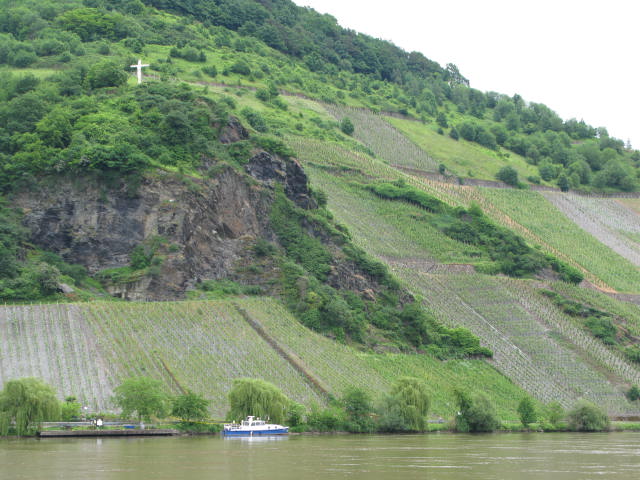Hi, everybody, gut-en mor-gen, and welcome back to Cépage et Cuisine, Frau Mary’s and Brian’s
blog about wine, food, culture, and geography.
Today, we transferred from Trier to Bernkastel, our fourth and final
vacation destination. Since Bernkastel
is so close, about 45 minutes on the main road and an hour-and-a-half on the
backroads, we were in no rush to be on our way.
I walked up the hill to the bakery to get Frau Mary her nougatplunder
for breakfast.
It is basically a glazed
pastry with a light drizzle of chocolate and a little chocolate inside, but not
like a pudding. It’s more like a
croissant on the inside.
For years I have read
about the Mosel Valley, tasted its wines, even conducted tasting events in our
home and the homes of others to learn and help others learn about the
wines. Of course, I’ve seen the photos
and videos, but none of that really prepared us for what we saw when we came
over a forested mountain above Trittenheim.
There, the Mosel makes a turn with Trittenheim on one side and Leiwen on
the other. Have a look at this video.
I think it must be said
that the Mosel and the villages and vineyards along its winding route are a
visual feast, stunning in the impression they convey. We were both thrilled by the view.
In the early afternoon
sun, you can see in this photo exactly how west-facing vineyards get more light
and, therefore, have better ripening potential.
Here’s another look at
Trittenheim as we descended the hillside.
This is Leiwen around the
bend in the river.
Our first impression of
the vineyards across the river is how steep they are.
The vines and rows are
practically dripping off the rocks and hillsides.
The church in Trittenheim
is architecturally typical of the style we’re seeing as we drive along in the
Mosel.
Trittenheim was a
convenient stop for lunch at the Weinstube Restaurant.
The daily special was
chili con carne over rice with a salad.
It’s not exactly German regional food, but it really hit a familiar food
spot.
We enjoyed it with a
local roséwein, a rosé of Pinot Noir.
As we drove the last 25
kilometers to Bernkastel, I felt I had to pull over every few feet to take
another photo. The vineyards and
hillsides are just so beautiful.
This photo is an
unintentional selfie. You see me in the
mirror, leaning out of my window to snap another photo.
This is the approach to
the village of Minheim.
This is the view across the
river to the vineyards above Wintrich.
Every small village has
at least one hotel that looks something like this, often right on the water,
often with a restaurant.
This is Schloss Leiser in
the town of Lieser. “Schloss” is
translated to English as a castle, manor, or mansion.
The castle was built
around 1884. Here’s a little history
about the castle, conveniently in English.
Here are some views down the
main street of Lieser.
We arrived in Bernkastel
and noticed the height of the Mosel. It
was creeping onto the banks and covering a bike path and some parking
places. There has been a lot of rain
during our trip as you may have noticed in earlier blog posts. Some cities, including Paris, have experienced
significant flooding.
The ruins of an old
castle, the Burg Landshut, loom above the town on a hilltop.
We went to dinner in the
old town of Bernkastel. Sure enough,
there are markings on the sides of buildings to indicate past floods of the
river. The December 1993 was a big one,
well above Frau Mary’s head.
We went to a casual
place, the Café Thiesen and had the regional specialty dish, again ...
... which is
smoked pork loin with mixed mashed potatoes and sauerkraut. The menu item is kasseler mit gräwes. It
tasted fine, but it is quite heavy. Back
in Mississippi, this would require a “go box.”
I also tried this soup,
called linsensuppe mit würstchen, a
lentil soup with sliced sausage, and really liked it.
The wine was this Joh.
Jos. Ehlen Riesling Bernkasteler Lay 2012 in the dry style, called trocken.
Kabinett means the grapes were picked at the first and lowest level of
ripeness. The next higher level is spätlese,
sometimes called late harvest, then auslese, which is like a dessert wine, then
the real dessert wines, beerenauslese and trockenbeerenauslese. I’ll talk about these levels in a later post.
The wine was fine, not
remarkable, but very enjoyable, in part because the grapes were grown within a
few hundred meters of the restaurant. It
did have good freshness with citrus and tree fruit flavor notes. It also serves an example of the rule of what
grows together goes together. It paired
nicely with the pork loin and the strong flavors of the sauerkraut.
Mary passed on the apple
strudel. The restaurant was cozy and the
food hearty on a chilly, drizzly evening.
We were glad to head on back to our apartment and get settled.
That’s our post for
today. We hope you liked it. Thanks for reading us at Cépage et
Cuisine. Tomorrow we
begin our exploration of the area and tasting great Riesling. Check back for more posts. In the meantime,
Prost! (see how much German Frau
Mary is teaching me already?)
Mary♥Brian




































Truely beautiful! I would like to know how they work the vineyards? Talk about steep! Danke
ReplyDelete